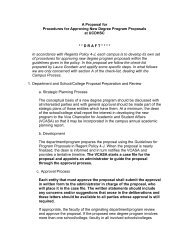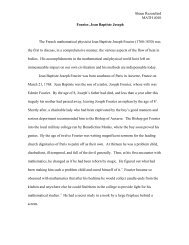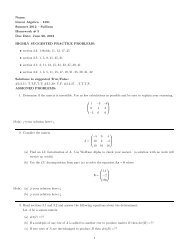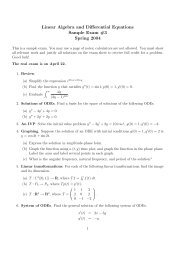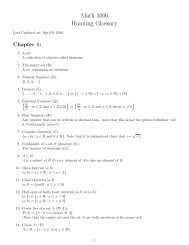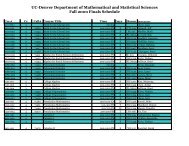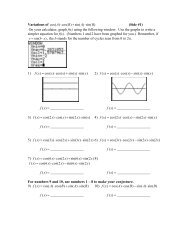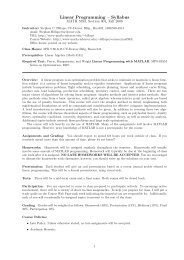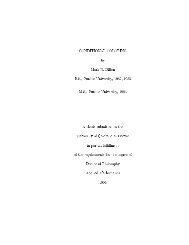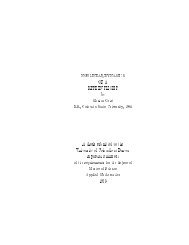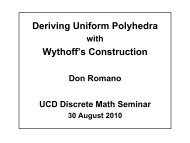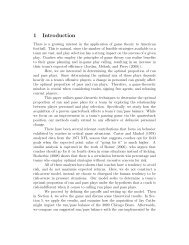University of Colorado Denver Math 1070 Topics Updated: Fall 2009 ...
University of Colorado Denver Math 1070 Topics Updated: Fall 2009 ...
University of Colorado Denver Math 1070 Topics Updated: Fall 2009 ...
You also want an ePaper? Increase the reach of your titles
YUMPU automatically turns print PDFs into web optimized ePapers that Google loves.
<strong>University</strong> <strong>of</strong> <strong>Colorado</strong> <strong>Denver</strong><br />
<strong>Math</strong> <strong>1070</strong> <strong>Topics</strong><br />
<strong>Updated</strong>: <strong>Fall</strong> <strong>2009</strong><br />
1. Solving Equations and Inequalities. (Some <strong>of</strong> this is review material which may be covered at a brisk pace.)<br />
Solve linear equations algebraically.<br />
Solve quadratic equations by factoring, square root method, completing the square, quadratic formula.<br />
Quadratic equations with complex solutions. (optional)<br />
Applications <strong>of</strong> linear and quadratic equations including business applications.<br />
Solve rational and radical equations algebraically.<br />
Solve linear inequalities algebraically and graphically.<br />
Solve quadratic, factored polynomial and rational inequalities.<br />
Solve absolute value equations and inequalities. (optional)<br />
2. Graphs<br />
Plot points in Cartesian coordinate plane. (optional)<br />
Find distance between two points and midpoint <strong>of</strong> a line segment. (optional)<br />
Sketch a graph by plotting points. (optional)<br />
Find intercepts <strong>of</strong> linear and quadratic functions algebraically and graphically.<br />
Test an equation for symmetry with respect to the x-axis, y-axis and origin.<br />
Find an equation <strong>of</strong> a circle and graph a circle. (optional)<br />
Calculate and interpret slope <strong>of</strong> a line and write the equation <strong>of</strong> a line in slope-intercept form.<br />
Graph lines by hand given a point and the slope as well as graph lines written in general form.<br />
Find the equation <strong>of</strong> a line given a point and the slope <strong>of</strong> the line, or given two points on the line.<br />
Find the equation <strong>of</strong> vertical lines and horizontal lines.<br />
Find the equation <strong>of</strong> perpendicular lines and parallel lines.<br />
Draw and interpret scatter diagrams.<br />
Distinguish between linear and nonlinear relations.<br />
Use a graphing utility to find the line <strong>of</strong> best fit by linear regression.<br />
3. Functions and Their Graphs<br />
Determine whether a relation represents a function.<br />
Evaluate functions.<br />
Evaluate the difference quotient where f is linear as well as quadratic.<br />
Obj100<br />
Find the domain <strong>of</strong> where f is a polynomial, rational or root function.<br />
Identify the graph <strong>of</strong> a function. Use the vertical-line test.<br />
Determine Even and Odd functions from a graph as well as from an equation.<br />
Use the graph <strong>of</strong> a function to determine where the function is increasing, decreasing or constant.<br />
Use the graph to locate local maxima and local minima<br />
Use a graphing utility to approximate local maxima and minima and to find increasing or decreasing intervals.<br />
Find the average rate <strong>of</strong> change <strong>of</strong> a function.<br />
Obj101 Obj102 Obj103 Obj104 Obj105 Obj106 Obj107<br />
Graph key functions “library <strong>of</strong> functions”: , , , , , , .<br />
Graph piecewise-defined functions by hand and with a graphing utility then evaluate.<br />
Transformations: vertical and horizontal shifts, vertical stretching & compressing, reflections about x-axis.<br />
Transformations: horizontal stretching & compressing, reflections about y-axis. (optional)<br />
<strong>Math</strong>ematical modeling: geometric problems, maximizing pr<strong>of</strong>it, minimizing cost, etc.<br />
Form the sum, difference, product and quotient <strong>of</strong> two functions.<br />
Form a composite function.<br />
Find the domain <strong>of</strong> a composite function.<br />
Determine whether a function is one-to-one.
Obtain the graph <strong>of</strong> the inverse function from the graph <strong>of</strong> the function.<br />
Find the inverse <strong>of</strong> a function defined by an equation.
4. Quadratic and Polynomial Functions<br />
Graph quadratic functions using transformations.<br />
Graph a quadratic function by hand by finding its vertex, axis <strong>of</strong> symmetry and intercepts.<br />
Find the maximum or minimum value <strong>of</strong> a quadratic function by finding the vertex (without technology).<br />
Build quadratic models from verbal descriptions as well as from data with technology by quadratic regression.<br />
Solve quadratic inequalities graphically by hand and with a graphing utility.<br />
Identify polynomial functions and their degree.<br />
Identify the real zeros <strong>of</strong> a factored polynomial function and their multiplicity.<br />
Use the rational zeros theorem to list the potential rational zeros <strong>of</strong> a polynomial function.<br />
Find the rational zeros <strong>of</strong> a polynomial function by long division or synthetic division.<br />
Find the complex zeros <strong>of</strong> a polynomial function.<br />
5. Rational Functions<br />
Determine end behavior, intercepts, turning points, domain/range and sketch the graph <strong>of</strong> a factored polynomial.<br />
Find the domain <strong>of</strong> a rational function.<br />
Find the vertical and horizontal asymptotes <strong>of</strong> a rational function.<br />
Find oblique asymptotes (optional).<br />
Analyze the graph <strong>of</strong> a rational function: find the domain, intercepts, asymptotes and graph by hand.<br />
Solve applied problems (business applications) involving rational functions.<br />
6. Exponential and Logarithmic Functions<br />
Evaluate and graph exponential functions.<br />
Convert from exponential to logarithmic form and vice versa.<br />
Evaluate simple logarithmic expressions without a calculator.<br />
Determine the domain <strong>of</strong> a logarithmic function.<br />
Work with properties <strong>of</strong> logarithms.<br />
Use the change <strong>of</strong> base formula to evaluate logarithms.<br />
Solve logarithmic equations algebraically and graphically.<br />
Solve exponential equations algebraically and graphically.<br />
Solve applications involving exponential growth and decay including compound interest problems.<br />
7. Sequences and Series<br />
Find specific and general terms in a sequence.<br />
Use factorial notation.<br />
Use summation notation to write partial sums <strong>of</strong> a series.<br />
Recognize and arithmetic sequence and find the sum <strong>of</strong> the first n terms. (optional)<br />
Recognize a geometric sequence and find the sum <strong>of</strong> a finite geometric sequence. (optional)<br />
Find the sum <strong>of</strong> an infinite geometric sequence. (optional)



